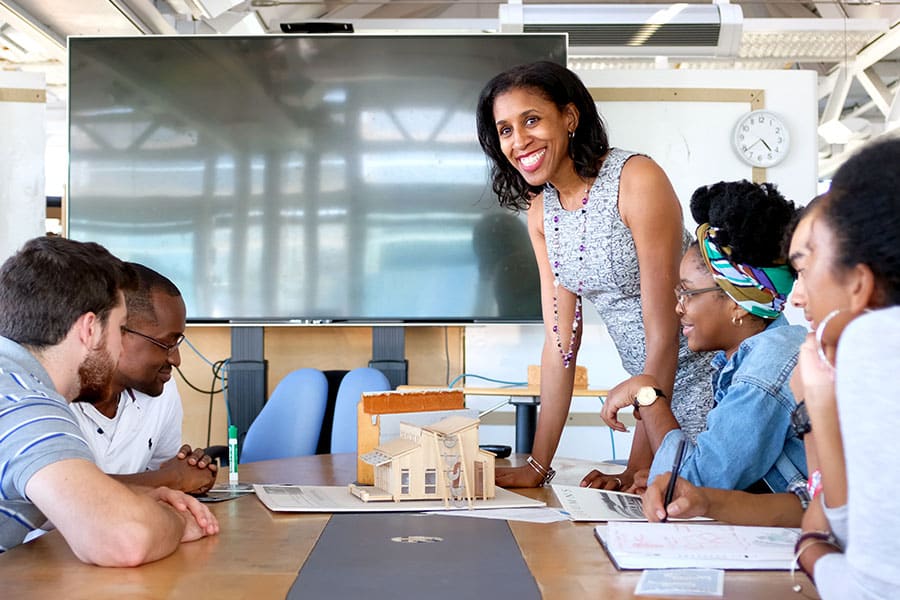Erica Cochran Hameen’s foundational journey into the world of architecture came from building with blocks, LEGOs and making things out of clay and cardboard as a child—but it’s her interest in larger society that’s triggered her passions in adulthood: sustainability and equity.
At her Brooklyn, New York, high school, Cochran Hameen attended an after-school program called Junior Engineer Tech Society to learn about science, technology, engineering and mathematics (STEM) as they relate to architecture and engineering. “When you think about the way we evaluate history and cities and buildings, it is shaped by people and decisions that the architects made,” she said.
Cochran Hameen is an assistant professor at Carnegie Mellon University’s School of Architecture and the school’s first director of diversity, equity and inclusion. She is also the first—and to date the only—African American woman to earn a doctorate degree from the university’s school of architecture, not to mention the first and only African American woman to be on the tenure track in that department.
Despite these outstanding achievements, Cochran Hameen would gladly trade in that “unicorn” status to have company in her field—company that would ideally include women, other people of color and, in particular, female minorities.
Equitable sustainability
As a nod to her upbringing in the church, Cochran Hameen has focused her career on giving back, with the mission of making life easier and better for people through sustainable architecture and design. Before she entered academia in 2009, Cochran Hameen’s work as a practicing architect was concentrated in the public sector: schools, churches, train stations, even toll booths to support bridges.
Building schools precipitated her passion for sustainability, as she noticed that pronounced economic disparities among different ZIP codes often resulted in a lesser-quality education for students.
“As I was working designing school renovations, school building additions and modernization, I saw differences in what was provided to different communities,” she said. “One school is amazing, and then you go to another neighborhood and you might see something dilapidated and things falling apart and an overcrowded building. I thought that the type of building and environment you put people in has a connection with how you learn. If a building is leaking and classrooms are overcrowded, you’re probably not going to get the same education as someone who goes to a school with great ventilation and A/C.”
This was the hypothesis for Cochran Hameen’s master’s and doctoral theses: how design decisions affect people’s health and productivity and result in long-term impacts.
The principles underlying the intersection of sustainability and equity continue to motivate Cochran Hameen, and she consistently conveys these teachings to her students. “Sustainability is about what it does for the planet,” she said. “I do believe true sustainability helps bring about equity. It’s all about people and equity and making sure we all have access to quality.”
One of Cochran Hameen’s top areas of research is indoor environmental quality—the conditions inside a building. “If we can show how the environment matters to people, how decisions we make about environmental quality affect children and people, maybe we can start designing differently so everyone has the same quality of schools, hospitals and offices and bring some level of equity in our architecture,” she said.
Diversity in academia
As Carnegie Mellon University School of Architecture’s first director of diversity, equity and inclusion, Cochran Hameen aims to make the curriculum—and the faculty and students—more inclusive.
She is hoping to bring back the award-winning Urban Design Regional Employment Action for Minorities (UDREAM) initiative that began at the school in 2008. At its inception, there were maybe three or four Black architects in all of Pittsburgh, Cochran Hameen said. The goal of diversifying the architecture industry, at least on a local level, included a 12-week internship for new talent, mentoring, education, volunteering and a guaranteed job.
“What we saw is that within nine years, the representation—the percentage of minority Blacks and Hispanics in the architectural field—increased by more than 400%,” she said. CMU benefited as well, as its architectural graduate school applications increased, with 85% of people coming through this outreach program.
“In those nine years, we also saw the first ever Black woman to be licensed in Pittsburgh,” Cochran Hameen continued. “From UDREAM, we were seeing all these firsts.” Also because of UDREAM, there are three African-American women who will be attending architecture school this fall at CMU, two of whom are in the doctoral program.

“Why is this so important? I went to CMU for graduate school, and I was the first and only Black graduate student to get a Ph.D. in the School of Architecture,” Cochran Hameen said. Now, as the school’s director of diversity, she hopes to help close the gap that has been historically present with people of color in architecture.
Cochran Hameen is also involved with the National Organization of Minority Architects (NOMA), whose mission is to promote diversity and which has a chapter at CMU. “One of my roles is to respond to the students’ demands,” she said, which has included more minority critics; lecturers; that guest speakers be at least 50% women; an inclusive syllabus; more diversity in visiting professors; and programs to improve retention among Blacks and Hispanics.
“Students have issued this call to action, and my job is to make it happen,” Cochran Hameen said. “I will make calls, I will write grants to fund scholarships, to be sure they can afford to be at CMU; that is what I do. My job is to provide a voice for these students and to make sure that they can get the best education that they can get.”
An eye toward the future
Cochran Hameen hopes that her students understand the importance of design decisions, as well as how designs are connected back to people and how sustainability is helpful to the planet.
“I hope I’m inspiring my students,” she said. “In class, I am sharing knowledge that they will use to go out and make the world a better place. I hope conversations resonate and make them think even after they graduate.”
Cochran Hameen also wants to continue to work in academia. “I want to get on my soapbox, shout about design quality and equity and sustainability and energy efficiency and try to change things so people are living happier and more comfortable lives,” she said. “I love doing this. I want to be in a position where I can make these policy changes happen.”
“I hope it’s easier for the next generation,” Cochran Hameen added. “Maybe they won’t ever say, ‘there was no one like me.’”












